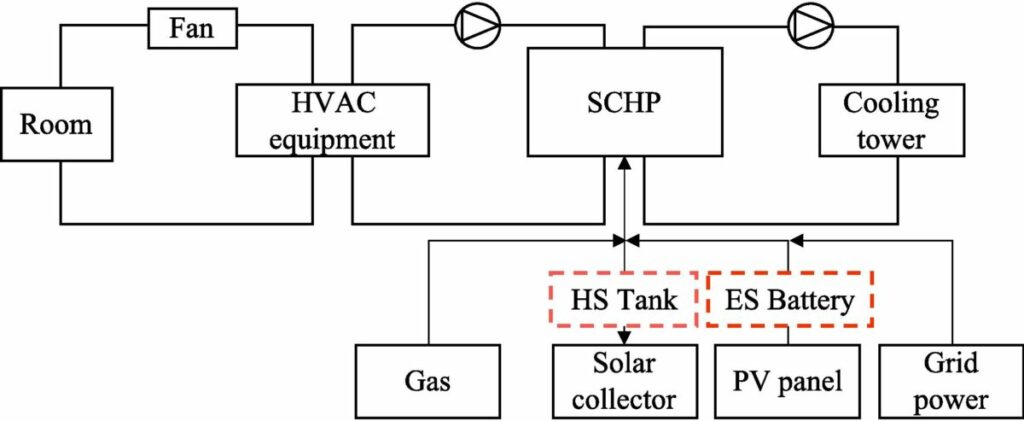The novel heat pump concept combines solar energy with chemical storage and reportedly consume 75% less electricity than conventional heat pumps. The system relies on a battery and a heat storage tank that can be used either separately or simultaneously, depending on the outdoor conditions.
May 30, 2024 Emiliano Bellini
Researchers from Chiba University in Japan have designed a heat pump system that integrates photovoltaic-thermal (PVT) energy with chemical storing involving an exothermic reaction that releases heat and an endothermic reaction that stores heat.
The proposed solar chemical heat pump (SCHP) is intended to provide heating and cooling in buildings and can reportedly consume 75% less electricity than conventional heat pumps, according to its creators. “The introduction of SCHP systems has significant energy, environmental and economic advantages,” the scientists said. “They can improve the energy efficiency of buildings, reduce carbon emissions and reduce running costs.”
In the study “Feasibility study with EnergyPlus simulation for solar chemical heat pump unit introduced into building as next-generation energy supply system,” published in Energy and Buildings, the academics explained that a SCHP unit generally combines solar thermal energy with a chemical heat pump subunit, adding that PV is used to power the circulating heat transfer fluid to efficiently capture, store, and use thermal energy.
Their prototype was constructed with a working pair combining calcium sulphate (CaSO4) and water. It consisted of several single CHP subunits connected in parallel, with the operational state of each subunit being configurable in response to the specific load demand.
The SCHP system is also connected to heating, ventilation, and air conditioning (HVAC) equipment, a cooling tower, and a unit integrating a heat storage (HS) tank, solar thermal collectors, PV panels, and a battery, as well as a connection with the power network and a gas source. Heat provided by the solar thermal collectors or the gas source is used for the dehydration reaction aimed at storing heat.
The system can operate in three different modes. In the first one, solar collectors combined with natural gas supply the thermal energy for the CHP subunits, PV panels produce power to charge the battery, and the battery provides power for the CHP subunits, without any use of grid electricits.
In the second mode, the PV panels and grid electricity provide power for the CHP subunits, solar collectors charge the heat storage tank, and the heat storage tank gives thermal energy to the CHP subunitsw, without requiring the gas source.
The third mode requires the solar collectors to charge the heat storage tank, PV panels to generate electricity to charge the battery, with the tank in turn providing thermal energy for the CHP subunits, while the battery provides circulation power for the CHP subunits, without any additional gas or electricity being needed.
The group conducted a feasibility study on the system assuming its deployment in a 20 m-high research builidng in Chiba. The battery and HS tank were sized to meet the energy demands of the building, which has a total area of 8,640 m2. “The simulation run period is from January 1st to December 31st, totaling 8,760 h,” it specified. The number of timesteps per hour had a maximum value of 60.
The simulation demonstrated that the battery, when used, can help reduce running costs by 30%, while HS tank was found to reduce these costs by 82%. “When both are imported, there is no need to consume external energy and the annual running costs approach 0 yen,” the academics highlighted.
The analysis also showed that the SCHP system is able to consume around 75% less electricity than conventional heat pumps, while also contributing to reduce CO2 emissions by up to 72%. “The running costs of the SCHP system in the building are significantly reduced, reducing running costs by 73%,” the team added. “Compared with the conventional system, the energy consumption in Sapporo, Matsumoto, Tokyo, and Kagoshima of the SCHP system is reduced by 83%, 86%, 80%, and 78%, respectively. The energy-saving effect is better in cold areas than in warm areas.”
The researchers specified that their modeling had some limitation due to the presence of the HVAC system and said future work should consider a more comprehensive economic evaluation. However, they concluded that the proposed system has “immense sustainable potential” as a next generation energy supply system.
This content is protected by copyright and may not be reused. If you want to cooperate with us and would like to reuse some of our content, please contact: editors@pv-magazine.com.
>>> Read full article>>>
Copyright for syndicated content belongs to the linked Source : PV-Magazine – https://www.pv-magazine.com/2024/05/30/japanese-researchers-unveil-solar-chemical-heat-pump-system-for-buildings/
